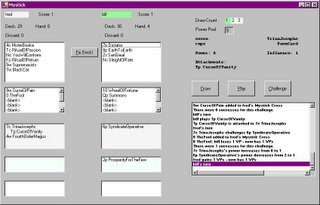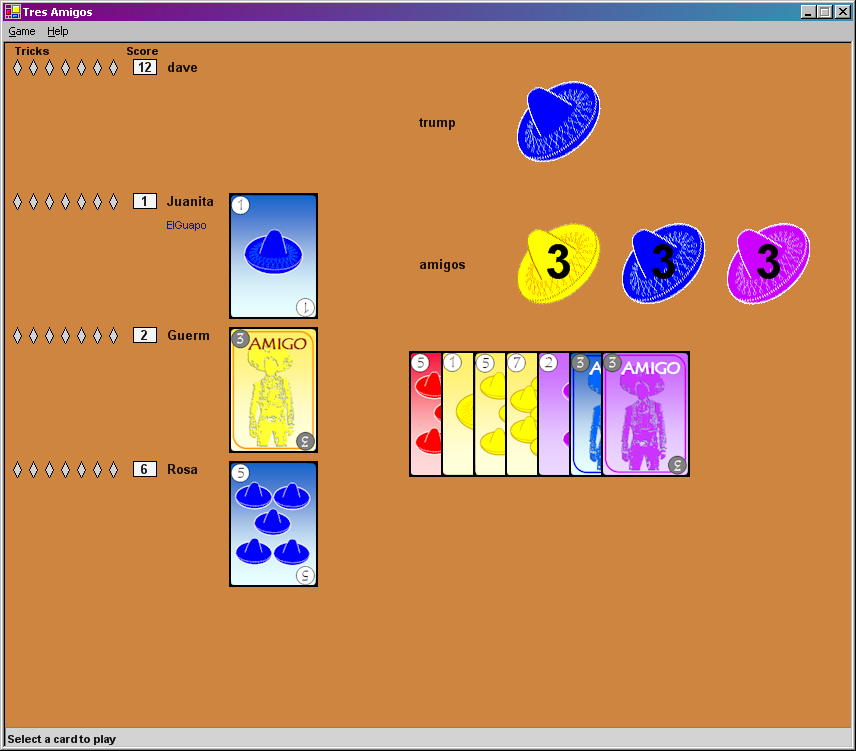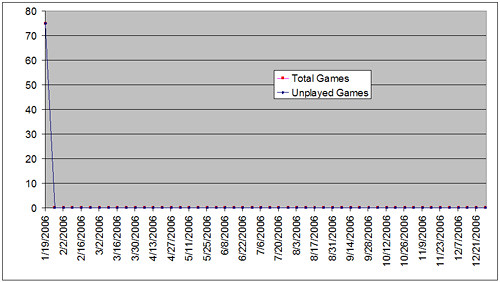Tuesday Tidbits
I hosted a SimplyFun party (run by Mike) at my house a couple weeks ago. We had about eight people there – good fun, and I think Chris had the event blogged before he got home. Picked up Drive and Zing (Die Sieben Siegal). Jodie and I played Drive (which is actually Michael Schacht's Crazy Chicken) a couple nights ago and it was "eh." Probably better with four. It seems to fill a similar niche to Coloretto, but isn't as good. At least it's playable with 2 where Coloretto is not. Looking forward to Zing as Chris and Mike both rank it as one of their top trick-taking card games.
I like the idea of SimplyFun. Being a gamer that likes the deeper games, however, I do find their catalog a tad fluffy. That is by design, of course, as they're emphasizing the social aspects of game playing. A concept I fully endorse. Anything that gets families and friends together and interacting instead of parking themselves in front of the TV set is a good thing. One thing that SimplyFun does that other game companies should note is the production style.
Here's the things SimplyFun does with their games that I wish other companies would do:
- Sturdy Boxes. Of course, they're nothing like the near bullet-proof box C&C: Ancients comes in, but they're very well made.
- Rules summaries on the front cover of the rules. VERY handy for a refresher after you've learned the game and just need to remember things like number of cards and turn sequence.
- Journals. Okay, for cost reasons I can see why this one isn't done. I've always liked the idea I heard way back when about keeping a sheet of paper in every game that details when the game was played, by who, and who won. SimplyFun includes a little (game-specific) booklet in each game specifically for this purpose. A nice touch.
Our Friday gaming group at work just loves Tanz der Hornochsen. I think we're up to six plays in that group – that might be our all-time high. It fills a good niche as it's not very complex, plays in an hour or less, and handles a large number of people. I'm open to other suggestions for games in this category. Frank's Zoo is another favorite that fits. (Criteria: 1 hour play time, handles 7 players, low complexity a plus but not mandatory. Chris would probably prefer it didn't contain simultaneous action selection.)
Got my copy of GMT's Commands and Colors: Ancients. This is Richard Borg's third entry in the Battle Cry/Memoir '44 series. Given that I'm a fan of wargames based in the 18th century or earlier, I'm predisposed to like this title. I haven't had a chance to play yet, but I did get all the blocks stickered up. I was setting the game out on Sunday when Mike came by and we chatted about it a bit. I think it'll end up being my favorite in the series due to the theatre and complexity. Mike wasn't too thrilled with the blocks, and I admit the game lacks the visual appeal of the earlier games. As discussed on Alfred's blog, 1/72nd plastic figures might be the way to go here, though getting two elephants or chariots to fit in those hexes will be a challenge. Might have to get creative with removable support figures or something.
Another wargame that arrived recently that (undeservedly) got shuffled away with holiday chaos was Flying Colors, also from GMT. This is a Napoleonic naval game that is geared for fleet actions, not individual ships. Well, "Napoleonic" is compartmentalizing it a bit. It does handle conflicts back into the Seven Years War as well. This is probably going to grab a spot in my solo gaming space. In fact, I better do that soon, because as soon as Here I Stand arrives, I'll be plonking that puppy down in eager anticipation of a six-player session.
On the miniatures side, I finally finished painting my 6mm Russian Cavalry for Peter the Great's army. All I have to do now is the artillery and command stands, and it's complete. The immediate need is for me to paint some Swiss skirmishers and pack horses for the DBM tournament at Conquest NW in a couple weeks. After that, I'm full bore onto Charles XII's Swedish army to take on those Russians. (then it's the Poles then Saxons... a miniaturists' job is never done...)





